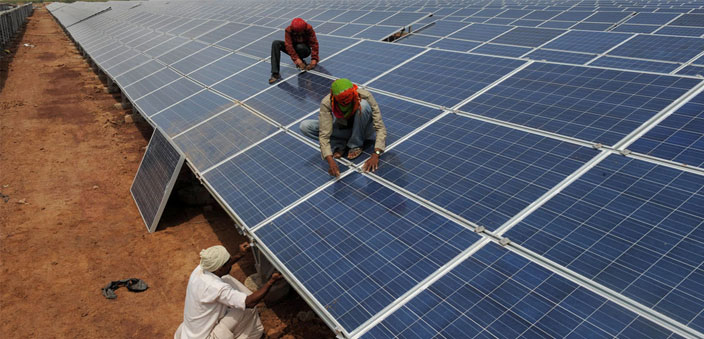When at United Nation’s Climate Change Conference held at Lima, Peru, in December 2014, Union Minister for Environment, Forest and Climate Change Prakash Javadekar said, the Government was “committed to protecting the interests of the poor,” and declared India was “at the frontline of facing the impact of climate change, where shifting rainfall patterns, recurring floods, stronger cyclones and droughts or soil erosion are exacerbating the challenge of poverty eradication and necessitate the allocation of scarce national resources for preventing loss of human life,” he was stating the obvious.
Javadekar had firmly maintained then that India’s measures to combat climate change through scaled-up solar mission, clean energy cess on coal, and afforestation efforts had been side-lined for years, even as a huge chunk of the global carbon space was occupied by industrialised countries. That apart, the minister also drew attention to the fact that of the $110 billion promised annually to fight climate change, only $10 billion was in place.
The needs for mitigation and adaptation as felt by “Developing countries were estimated in the range of $600 to $1,500 billion a year,” he pointed out before adding, “If there is no clear roadmap in the provision of public resources by developed countries to provide new and additional financial resources approaching $100 billion annually by 2020, and rising thereafter, then outcomes will be sub-optimal for a safer world.”
More important, he stressed the Intended Nationally Determined Contributions (INDCs) were to be ‘nationally determined’, and that there was no role for any ex-ante review in the process.
‘Convenient’ action to tackle ‘inconvenient’ truth
So, it was only inevitable for India to submit its INDC on Gandhi Jayanti-(birth anniversary of Mahatma Gandhi) the very next year, October 2, 2015, modelled on the vision of equity inspired by Gandhi’s famous exhortation: Earth has enough resources to meet people’s needs, but will never have enough to satisfy people’s greed. Prime Minister Narendra Modi has called for ‘convenient action’ in order to deal with the ‘inconvenient truth’ of climate change.
Cut to today, and the United State’s regression from climate action in which President Donald Trump did a predictable repeat of predecessor George W. Bush by ensuring US withdraws from yet another international treaty that commits parties to reduce carbon emissions to tackle global warming.
And, if you felt that the United States was the only ‘developed economy,’ to withdraw, think again. A string of developed economies like Australia and Russia too have been faltering on climate action. So, it isn’t of any surprise to have the world look eastwards to fill the leadership vacuum in climate governance and push for collective efforts to combat climate change.
China, the new leader?
This has paved the way to global climate leadership for China and India, who have demonstrated huge credentials, commitment and leadership potential by taking positive action in significantly reducing carbon emissions.
Following the ‘airpocalypse’ at Beijing triggered by coal smokes and power plants and a rise in air pollution killing an estimated 1.1 million people every year, at Communist Party’s annual congress, Premier Li Keqiang declared war on air pollution in China. At a party congress, he renewed his vow “to make our skies blue again.” This, China intends doing by reducing the production of steel and coal-fired electricity. And, to replace coal, China is creating the world’s biggest investment in wind and solar power.
The benefits will be phenomenal considering China is the world’s largest emitter of climate-warming greenhouse gases. With India surging ahead, internationally, it was only inevitable for China to make its shift in the matter of climate governance, from an insular foreign policy, towards a more internationalist stance.
China, however, is in no principled position to push other nations take up more ambitious climate targets. A huge sense of climate scepticism dominated the national discourse in China where climate change is seen as a “western conspiracy to constrain the development of China and other developing nations”. This raises doubts about China’s commitment to active climate leadership. In this context, China’s sentiments bear similarity to President Donald Trump’s views on climate change.
So, with the US withdrawal from the Paris Agreement, and China failing to inspire confidence among world players, India could effectively counterbalance the existing climate leadership equilibrium. Even India’s Energy Minister Piyush Goyal maintained India would stand committed to its climate goals laid out in the Paris Agreement irrespective of “what happens to the rest of the world.”
‘Above and beyond’ the Paris Agreement
India’s Prime Minister Narendra Modi has vowed to go “above and beyond” the Paris Agreement on climate change. This is indicative of India’s decisive leadership on climate change on a global scale.
Firmly on the path of a clean energy revolution, and making pertinent accomplishments, as a strategy to reduce its emission, India has embarked on a massive renewable energy programme. Augmenting the National Solar Mission, India has set a lofty target of 100 gigawatts (GW) of installed solar energy capacity by 2022 – five times more than the original 20 GW target. And in keeping with plans, India has recently become the world’s fourth largest producer of wind energy in the world, and cancelled 14 GW of coal plants last year.
However, a section of the civil society feels a major constraint that plagues pollution control in India is its weak capacity to administer, design and implement rules or policies. Despite pushing through certain legislations and adopting the principles needed for sustainability, implementation needs to be ensured.
As per a study by IIT, Kanpur, road dust accounts for 38 per cent of Delhi’s pollution. Now, in order to reduce the dust, municipal corporations will have to manage construction activities better. Contractors need to spray water to eliminate dust, cordon off construction areas, complete projects in a time-bound manner, use drilling instead of digging, among other things.
A section of the civil society feels, that can be possible only if the Public Works Department (PWD) regulating this be less corrupt and a lot more competent. The government would have to start by imposing regulations and raising penalties for non-compliance and disciplining engineers who did not enforce the rules.
Also, Pollution Control Boards (PCBs) don’t have the features of a modern regulator apart from some legislative powers. There is no mechanism to ensure accountability or transparency too, feel some.
Looking at the global scenario, it may be recalled that India signed and ratified the 1997 Kyoto Protocol in August 2002. India, China and other developing countries were exempt from the requirements of the Kyoto Protocol because their contribution to the emission of greenhouse gases during the industrialisation period was not significant. With time, it was perceived that both India and China would be among the leading contributors to greenhouse gas emissions.
But then, at the G-8 meeting in June 2005, India pointed out the per capita emission rates of the developing countries are a tiny fraction of those in the developed world.
The major responsibility of curbing emission rests with the developed countries, which have accumulated emissions over a long period of time, and that is conveniently ignored by the developed world at large.
Legislation and policies to ensure compliance
Where India is concerned, it has, of its own accord passed a string of legislations, even introduced policies in this regard. For one, India’s National Auto-Fuel Policy mandates cleaner fuels for vehicles. Also, the Energy Conservation Act, passed in 2001 puts out initiatives to improve energy efficiency. The Electricity Act of 2003 encourages the use of renewable energy.
India, following an amendment to its Constitution in 1976 included in Article 48(A) of Part IV: “The State shall endeavour to protect and improve the environment and to safeguard the forests and wildlife of the country.” Article 51 A(g) imposed additional environmental mandates on the Indian state.
Other Indian laws include the Water (Prevention and Control of Pollution) Act of 1974, the Forest (Conservation) Act of 1980, and the Air (Prevention and Control of Pollution) Act of 1981. The Bhopal gas tragedy triggered the Government of India to enact the Environment (Protection) Act of 1986. India has also enacted a set of Noise Pollution (Regulation & Control) Rules in 2000. In 1985, the Indian government created the Ministry of Environment and Forests which regulates and ensures environmental protection.
Starting in the 1990s, extensive reforms were introduced, and for the first time in Indian history, major air pollutant concentrations dropped in every five-year period. Between 1992 and 2010, satellite data confirms, India’s forest coverage has increased for the first time by over four million hectares, a seven per cent increase.
Braced to be among the worst hit by adverse effects of climate change, India has been bolstering its resources – both legislatively within, and through firm policies across borders, to overcome the problem. India has, for once, begun to talk tough on environment, but will have to walk the talk too!


 [/column]
[/column]